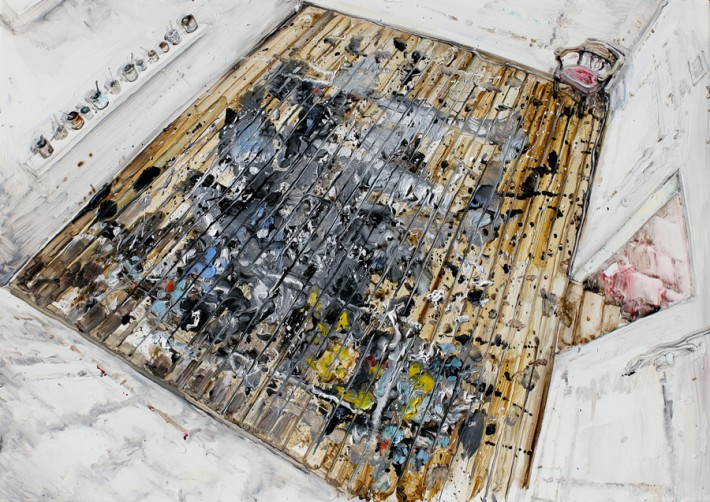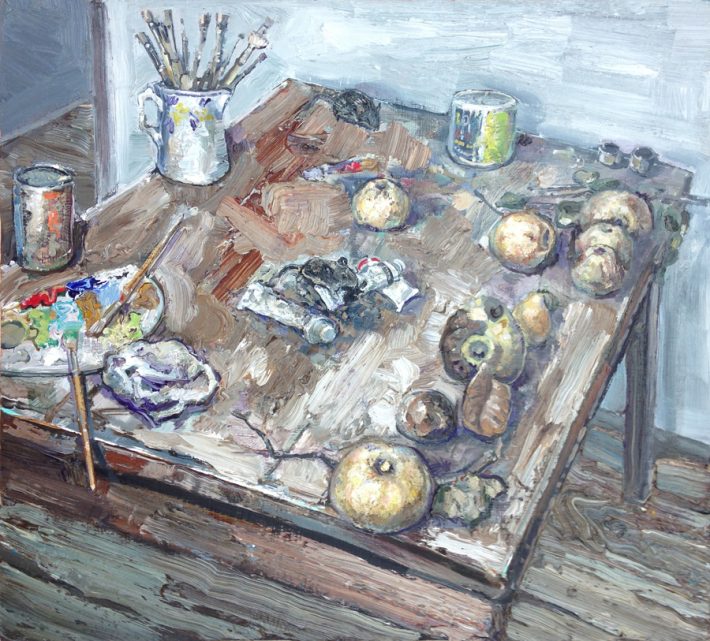THE NEW ORLEANS ART REVIEW
VOL. 32, NOS. 3-4 SPRING 2015
AMER KOBASLIJA
Paintings
Arthur Roger Gallery
New Orleans, LA
BY KATHY RODRIGUEZ
THE ROMANTIC IMAGE of the solitary painter, alone in a garret studio, strenuously working at a paint-spattered easel in the dead of night, certainly persists in many imaginations. That painter is charged, obsessed with the work – drunk on wine or turpentine, weary from extended periods of insomnia, living in relative filth. Despite the perceived stink of such a scene, it is an engaging thought that captures the creative vision of the uninitiated into studio practice in painting.
From paintings by Amer Kobaslija at Arthur Roger Gallery, it appears that the imagined situation is not much different from standard, fanciful mental wanderings. Painting is a dogged process, even if spontaneous – the activity of painting might be perceived as sedentary, but the work is immense. This is also reflected in the exploded scenes of dirty laundry, stacked canvases, decrepit furniture, and dirty floors in the often fluorescently-lit spaces depicted in three-point perspective that fill Kobaslija’s panels. Worn chair seats might bear the deep indentations of a painter’s continued presence, but the brushwork itself indicates the action of the work.
The paintings range from small to sublimely large scale, but the subject matter remains basically the same. Palettes change slightly to accurately represent the light in the spaces. Specific details are different. The skewed perspective remains consistent as well, positioning the viewer like a “fly on the wall,” or ceiling, peering over the space without the painter present. This is certainly a coveted view for many, who crave access to even the physical remnants of the creative process. It seems akin to buying printmakers’ plates after they have been cancelled, or the painter’s mangled brushes at auction. Looking at aspects of the process should impart a miraculous experience into the artist’s psyche, like touching relics while on pilgrimage.
In each of the paintings, the paint itself is applied in an expressionist manner. It is tactile and above the surface of the panel or Plexiglas substrate. The physicality of the paint is also like a relic – it is the index of Kobaslija’s presence, and a symbol for the presence of the painter absent from the scene he depicts.

Amer Kobaslija: Studio Floor (J. Pollock, E. Hamptons), 2014. Oil on Plexiglas, 12” high.
At least two of the painters –Jackson Pollock and Balthus – whose studios appear in the paintings are no longer of this world, forever physically absent from their spaces. Images of Pollock’s studio floor offer the reverse view of Hans Namuth’s film of the painter at work, positioned over his camera and painting on glass. The Plexi substrate of Kobaslija’s paintings points directly to this context. The brushstrokes in this work are like trompe-l’oeil renderings of the traces of paint on Pollock’s floor, where he laid canvases to dance around them while flinging paint from sticks.
The vision of Pollock, though, does not account for the destructive force associated with his personality and found in his action paintings. The paint explodes over the surface, tormented by the artist’s erratic motions, covered and, more recently, cracking from the canvas surfaces onto which it barely adheres. The delicacy and vulnerability of these paintings starkly contrasts the Romantic violence with which they were created.
A thread of uncontrolled, or uncontrollable, violence emerges in a comparison of these paintings to Kobaslija’s other works. The painter won a Guggenheim fellowship in 2013 for his work depicting the aftermath of the 2011 tsunami that destroyed Kesennuma, a coastal town in northern Japan. Kobaslija’s wife is Japanese, and the artist states he felt compelled to make paintings to “engage.” The paintings share the stretched perspective and foreshortening of the studio images. Here, though, they suggest an uncertain and elongated future, into decades of reconstruction. Their sense of a stretch of time is stronger than in the paintings at Arthur Roger, though the connection of time in studio space is certainly suggested, especially through the accumulation of stuff throughout the illusionistic spaces. Sublime nature has terrorized humanity in these images, and humanity strives to grow back. In addition, the artist immigrated from Bosnia – his childhood home – in the nineties. Images of the chaos and destruction in that place also emerge from the stilled destructions depicted in his scenes of studios.
The paint takes on another character, especially as it represents space. The cluttered scenes suggest the interior of the creative mind, resting for a moment between periods of mania. Pollock is a fairly recent example of the persistence of the idea of artistic genius – the mad, melancholic painter, much like Michelangelo in creating heroic masterpieces. Kobaslija offers a view into the mental state, and perhaps the contained brain itself, symbolized through the “skull” of the studio walls, that binds the brain inside a constricted area. Like Hannibal Lecter removing a bit of tissue from his victim’s opened cranium, Kobaslija excises a scene from the frenetic activity of the studio/brain.

Amer Kobaslija: Still Life with Paint and Quinces (Balthus’ Table), 2010. Oil on panel, 12 ½” high.
Kobaslija also made studies of Balthus’ studio. This painter, whose work was curated into a retrospective exhibition titled “Cats and Girls” during the feline-friendly exhibition year of 2013, is best known for his psychologically ambiguous, sexually- charged figurative and narrative paintings. His work explores madness, too, in a way, or at least deviance. In one of Kobaslija’s images, the viewer is offered a still life of paint and quinces set on a tabletop. The fruit bears obvious reference to breasts, a kind of symbolism that is common to the genre, and the paint to both artists’ medium of choice. Although scattered over the table, the title of the work as “still life” references a purposeful arrangement.
Press for the exhibition “Objects to be Contemplated,” a two-person show with Kobaslija at Ringling College, states that this show closed just last month. In the painting at Arthur Roger, Kobaslija seems to offer the still life as evidence of a moment of quietude. If the average viewer spends just a few seconds in front of the work, despite the hours of time devoted to creating it, Kobaslija’s intent in this work seems fair, to balance out the investment by offering a chance for contemplation.

Amer Kobaslija: Sputnik Sweetheart of New Orleans and the End of the World, 2007. Oil on panels, 85” high.
The largest work in the show, titled Sputnik Sweetheart of New Orleans and the End of the World, physically involves the viewer through its immense scale. Sublimely large like Pollock’s most recognized work, and spread over the back wall of the gallery, the vantage point taken by the painter is appropriately positioned on the wall so that the viewer, standing in front of it, is tactilely arranged to feel as though they are spread across the ceiling parallel to the floor. One feels, perhaps, like Vik Muniz standing over a pile of meticulously arranged trash, revealing the portrait through his photograph. This scale only intimates the expanse of creative possibility contained within the studio, though the viewer might feel more involved in the scene. The series of studio interiors is ongoing, and the experiences of standing before this one work suggests its possibilities are limitless.
This show marks Kobaslija’s first exhibition with Arthur Roger. In this city, the concepts with which Kobaslija works are consistently manifest. Madness and destruction pair with burgeoning genius and creation. The vibrance of the activity of the arts is tempered by the difficulty of supporting them, in addition to the inventive ways in which the arts are practiced and continued. The city seems a fair home for the painter. One wonders if continued views of a studio here will serve as a metaphor for life here as well.
